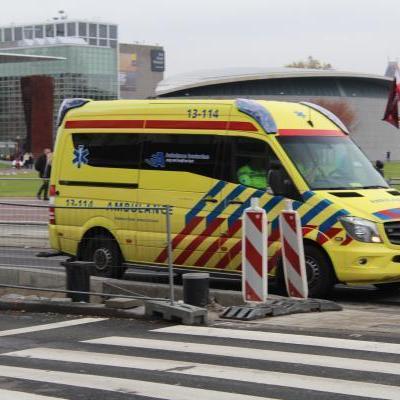Ambulance driver (Ambulancechauffeur)
Information on this skill...
An ambulance driver is a specially trained driver who is responsible for driving the ambulance. An ambulance driver is not a doctor or nurse, but may perform medically supportive actions in addition to driving the ambulance. An ambulance driver is therefore not only responsible for driving the ambulance. As an ambulance driver, you also assist the ambulance nurse in his or her work. Because as an ambulance driver you will regularly drive emergency rides, the ambulance driver has completed an extensive driving training, in which the ambulance driver also learns to perform medically supportive actions. As an ambulance driver, you transport patients to and from the hospital, and you are usually the first responder on the scene with patients, together with the ambulance nurse. Because driving an ambulance requires special skills, ambulance drivers have undergone extensive driving training. In short, we can best describe the work of an ambulance driver as transporting patients, the ambulance nurses and yourself as an ambulance driver in a safe way. In addition, an ambulance driver has the important task of maintaining communication with other emergency services, such as the control room, the fire brigade and the police. It goes without saying that an ambulance driver regularly has to deal with emergency transport, where general safety is highly regarded. As an ambulance driver, you are therefore not only responsible for supporting nursing actions. Think, for example, of supporting patients, bystanders and family. Other activities include carrying out general checks and minor maintenance on the ambulance. An ambulance driver therefore has more tasks than just driving the ambulance.
An ambulance driver is therefore an emergency worker, who is mainly responsible for driving an ambulance. As described earlier, ambulance drivers must undergo extensive driving training to be allowed to drive an ambulance. An ambulance that uses optical and acoustic signals is a priority vehicle for which special rules apply. Learning to drive a priority vehicle such as an ambulance requires extensive training to prevent accidents. For example, if a general practitioner calls an ambulance service, the ambulance service will first determine the urgency of the ride. Ambulance services have three urgencies, with the A1 urgency being the heaviest. If an ambulance service gives an A1 emergency to the ambulance driver, he may drive as a priority vehicle because it concerns emergency transport. Emergency transport relates to life-threatening situations such as resuscitation, myocardial infarction or a serious accident. Just like the ambulance driver, the ambulance nurse is not a doctor but a nurse, who specializes in giving emergency medical procedures that under normal circumstances would be performed by a doctor. In urgent emergencies, an ambulance nurse can call in a trauma doctor who in many cases will be flown in through the middle of a special trauma heli. Within the Netherlands there are about twenty-five regional ambulance facilities (RAV).
CONDITIONS WORKING AS AN AMBULANCE DRIVER
An ambulance driver must have a first aid diploma and resuscitation diploma and have a driving license B, C and / or C1 to be allowed to drive the ambulance. It is also the ambulance driver who will maintain contacts with the control room and other emergency services, such as the police and fire brigade. Although the ambulance driver is not a nurse, he does receive lessons in certain medical skills, such as obstetrics and psychiatry. A new ambulance driver will usually receive a driving course, which lasts about thirty days. Both the theoretical side and driving in practice are discussed here.
PRIORITY VEHICLE
The various emergency services in the Netherlands, such as ambulances, become so-called priority vehicles when they drive with flashing lights and / or sirens. They have special powers, such as being allowed to drive faster than allowed and being allowed to drive through a red traffic light. Although an ambulance can be a priority vehicle, this does not mean that there are no rules at all. During the driving training to become an ambulance driver, there is therefore a lot of attention for driving a so-called priority vehicle.
WHAT DOES AN AMBULANCE DRIVER DO:
TRAINING TO BECOME AN AMBULANCE DRIVER
Anyone who aspires to a career as an ambulance driver will first have to apply for a job at a regional ambulance service. When someone is hired, the prospective ambulance driver must follow a driving course that is only given at the Academy for Ambulance Care in Harderwijk. No special prior training is required for the position of ambulance driver, but in general at least a suitable MBO diploma level three will be expected. You will also need to have the driving license and a first aid diploma to be able to participate in the training.
COMPANIES WHERE AN AMBULANCE DRIVER CAN BE EMPLOYED
As an ambulance driver, you generally work for an ambulance service, which is spread over different regions in the country. In addition, an ambulance driver can work for independent ambulance services that specialize in the repatriation of patients from abroad.
COMPETENCES AMBULANCE DRIVER
The most important competence as an ambulance driver is surely your sense of responsibility because the responsibility not only relates to driving but also to the provision of care. In addition, you must, of course, be able to work well with the various colleagues and other care providers. Of course, your communication skills as a healthcare provider must be good. Your driving skills as an ambulance driver must be sublime so that you always arrive at the location in a safe way and also come back without accidents. Generally important words are insight, planning, consultation, decisiveness, professionalism and stress resistance.
LABOUR MARKET PERSPECTIVE AND CAREER OPPORTUNITIES AS AN AMBULANCE DRIVER
The labour market perspective as an ambulance driver is fairly good, but can vary per region. There are no real specific career opportunities as an ambulance driver. However, it is of course possible that sooner or later, you will continue to learn to become a nurse, for example, so that you can grow within healthcare.
WORKING CONDITIONS AND SALARY AMBULANCE DRIVER
On the website of ambulancezorg Nederland you can find more information about the employment conditions as an ambulance driver. An ambulance driver usually earns a salary between 2500 and 3500 euros gross per month, depending on age and years of service.
The content on this page has been automatically translated from the Dutch language. For this reason, texts and videos on this page may contain small errors.
Lesen Sie diese Informationen auf Krankenwagenfahrer auf Deutsch.
Lea esta información sobre Conductor de ambulancia en español.
Lees deze informatie over Ambulancechauffeur in het Nederlands.
Mijnzzp.nl


